Expert's Rating
Pros
- Camera captures 2K video
- Person, animal, package, and vehicle detection
- Lights and camera can be triggered by audio as well as motion
- Can be mounted to a ceiling as well as a wall
Cons
- Subscription required to unlock video recordings and event notifications
- Anemic onboard siren
- Motion-detection zones are limited to rectangles
Our Verdict
The Arlo Wired Floodlight Camera is an affordably priced floodlight/security camera combo that captures video in crisp 2K resolution and casts bright pools of light where it’s installed. But the competition in this space is fierce, and one of this product’s drawbacks is that you’ll need to buy a subscription to get full use of it.
Price When Reviewed
This value will show the geolocated pricing text for product undefined
Best Pricing Today
Considering how long Arlo has been in the home security game, including—for a short time—smart lighting devices, it’s a bit of a surprise that it took the company this long to offer a wired floodlight camera. It’s already on its third generation of battery-powered models (the Arlo Pro 3), but the Arlo Wired Floodlight Camera is its first effort building a camera/light combo with the reliability of hardwired power.
The competition in this space has gotten fierce, with Blink, Eufy, Google Nest, Lorex, Ring, Wyze Labs, and a host of lesser-known competitors duking it out. One of the most uncommon features of Arlo’s camera is that it can be mounted to a ceiling as well as a wall.
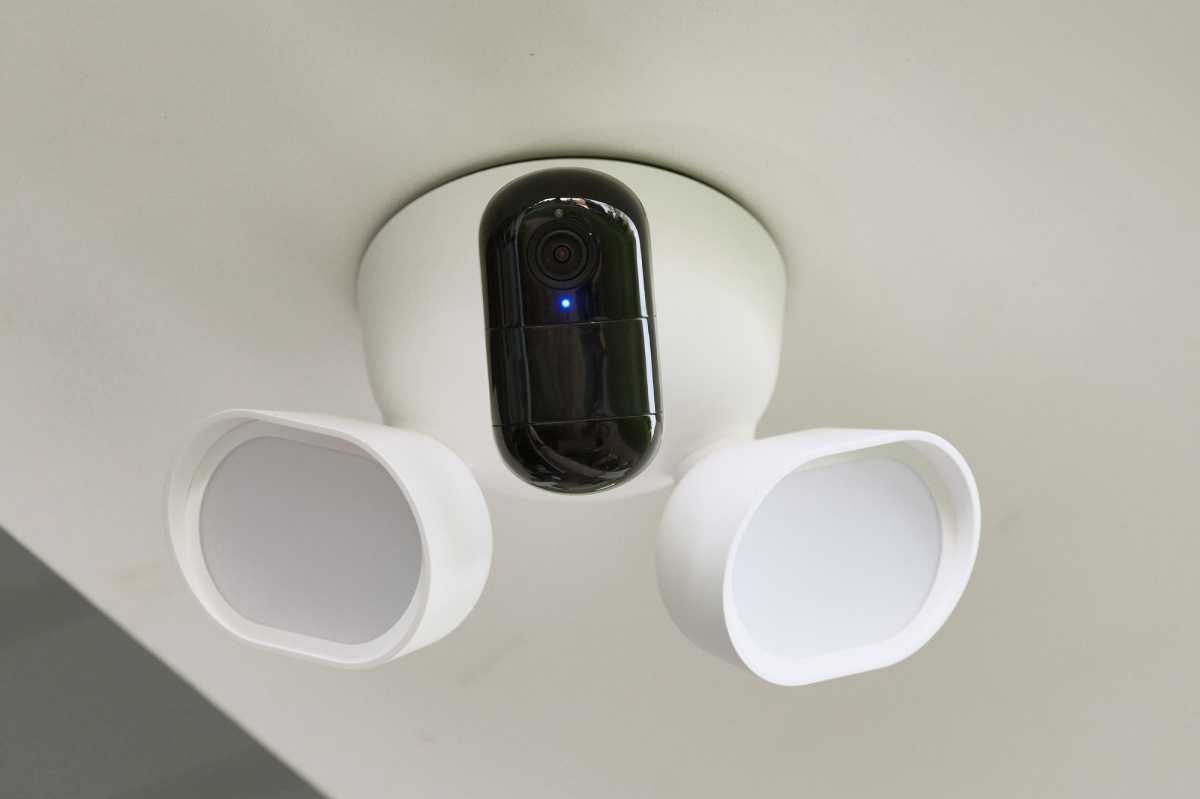
You can elect to mount the Arlo Wired Floodlight Camera to a ceiling and invert its video feed 180 degrees.
Michael Brown/Foundry
As is common with many security cameras, you’ll want to factor in the cost of a subscription before buying an Arlo Wired Floodlight Camera, because it can only be used for viewing a live video stream without one. Unless you pay, it won’t record events and store those clips in the cloud. Arlo doesn’t offer any means of local storage, either on the camera itself with a microSD card or on network-attached storage (several Eufy floodlight cameras offer both of those options).
We have since learned, however, that Arlo plans to release an update in 2025 that will enable this floodlight camera to record video to one of its SmartHub accessories–the Arlo Pro SmartHub or the Arlo Ultra 2 SmartHub, accessories you connect to your home network that can store camera recordings on a user-supplied microSD card or attached USB storage device.
We have also verified that video is encrypted when it’s sent to Arlo’s servers, and with a subscription, when you stream it back from Arlo’s servers.
The Arlo Wired Floodlight Camera captures crisp, clear, color-accurate video in 2K resolution with HDR.
Before Ring changed the pricing structure for its own services, Arlo’s plans were among the most expensive. That’s no longer the case. Arlo offers three tiers of service: Arlo Secure Basic ($8/mo or $80/yr for 30 days of storage from a single camera; $11/mo or $/130yr for the same for unlimited cameras); Arlo Secure Plus ($18/mo or $180/yr for unlimited cameras with the addition of several features, including audio, person, package, and vehicle detection); and Arlo Secure Premium ($25/mo or $250/yr for unlimited cameras with 24/7 professional monitoring, 24/7 emergency responder dispatch, and other features relevant to the company’s home security system).
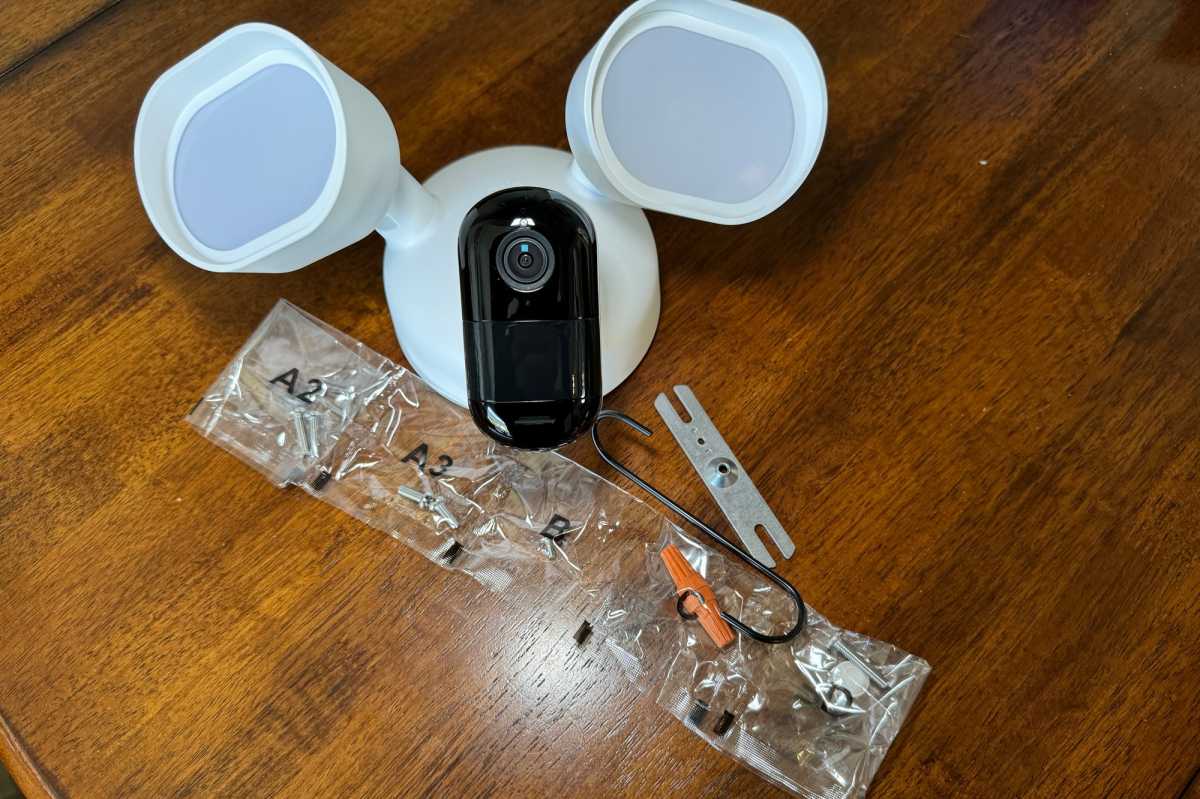
Don’t be intimidated by all the screws that come with the Arlo Wired Floodlight Camera. You’ll only need the ones that are the right type for your particular installation needs.
Michael Brown/Foundry
And like most cameras, this one is compatible with Amazon Alexa and Google Home (Apple HomeKit being a whole other kettle of fish), allowing you to view a live stream on an Echo Show or Nest Hub smart display in addition to a smartphone or tablet with the Arlo app installed.
This review is part of TechHive’s in-depth coverage of the best home security cameras.
Specifications
The Arlo Wired Floodlight Camera’s $150 price tag makes it cheaper than the Ring Floodlight Cam Plus ($200) and the Nest Cam with Floodlight ($280, but frequently on sale for much less), both of which offer lights with similar brightness (the Nest product is slightly brighter at 2,400 lumens), but both of those models’ cameras offer only 1080p video resolution.
Arlo’s product is more expensive than the budget-priced ($90) Wyze Labs Floodlight V2, which has brighter floodlights (2,800 lumens) and a camera with the same 2K resolution (2560 x 1440 pixels in the case of Arlo’s camera).
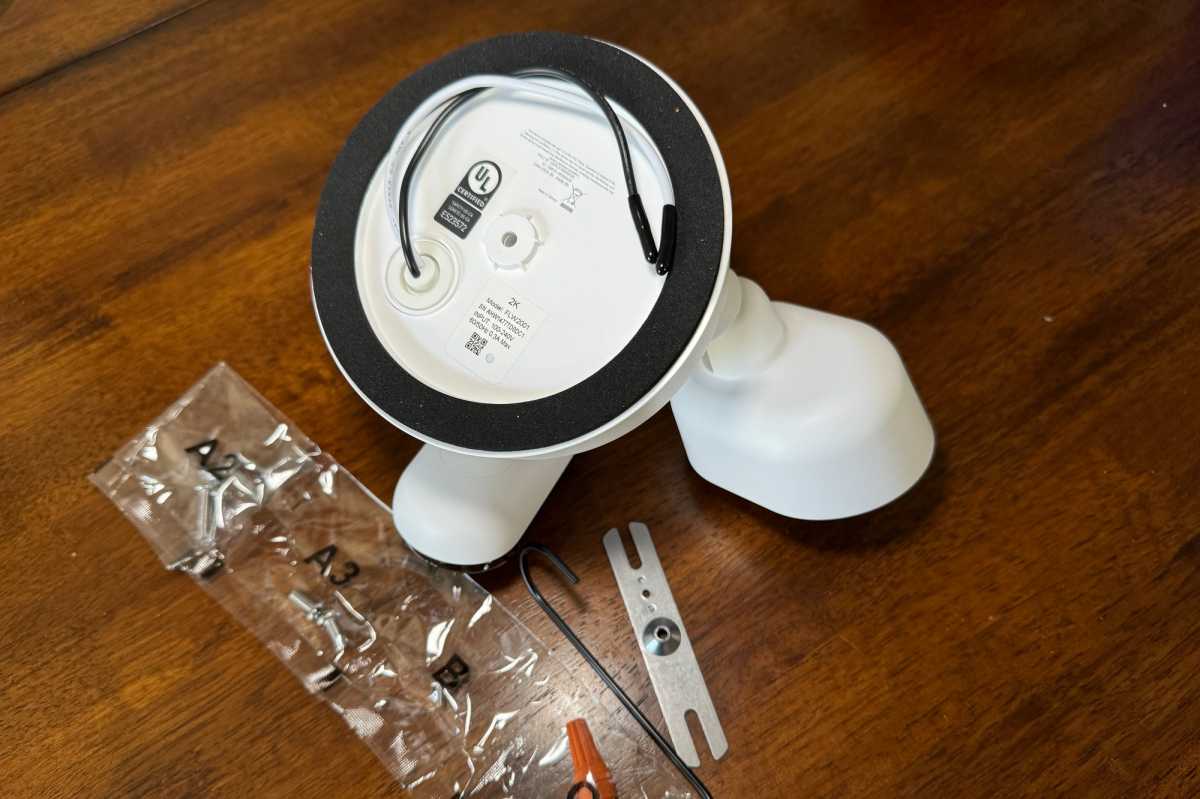
There’s a foam gasket encircling the wall side of the Arlo Wired Floodlight Camera, but applying a bead of caulk to the top half post installation will provide extra protection from water ingress.
Michael Brown/Foundry
The Arlo Wired Floodlight Camera is fabricated almost entirely from plastic, but it feels sturdy and capable of withstanding exposure to the elements. I reviewed the white model, but it’s also available in black. The camera is mounted on a stalk between and slightly below its two oval LED floodlights. All three of these elements can be aimed up, down, left, and right independently of each other
Here are the Arlo Wired Floodlight Camera’s full set of specs:
- Camera: 2K resolution with HDR, B&W and color night vision
- Camera field of view: 160 degrees
- Motion detection: Up to 5 detection zones with person, animal, vehicle, and package detection
- LED Floodlights (2): 2,000 lumens of brightness (fixed white color temperature, but dimmable)
- Two-way audio
- Onboard siren (triggered or on demand)
- Single-band Wi-Fi adapter (2.4GHz, 802.11b/g/n)
- Amazon Alexa, Google Home, and IFTTT compatible
- Available in black or white
Installation and setup
I found the Arlo Wired Floodlight Camera physically easy to install, even without watching the well-produced step-by-step video inside its app.
It comes with a mounting bracket that you’ll attach to the electrical box on (or inside) your wall (a variety of sets of screws are provided for this purpose, since those screw-hole dimensions can vary). Arlo provides a wire S hook that you can use to hang the camera from bracket while you’re wiring it up. Just two wires extend from the device, which you’ll fasten to the hot and neutral wires coming from your home with wire nuts (also provided). The ground from your home’s wiring gets attached to the camera’s mounting bracket.
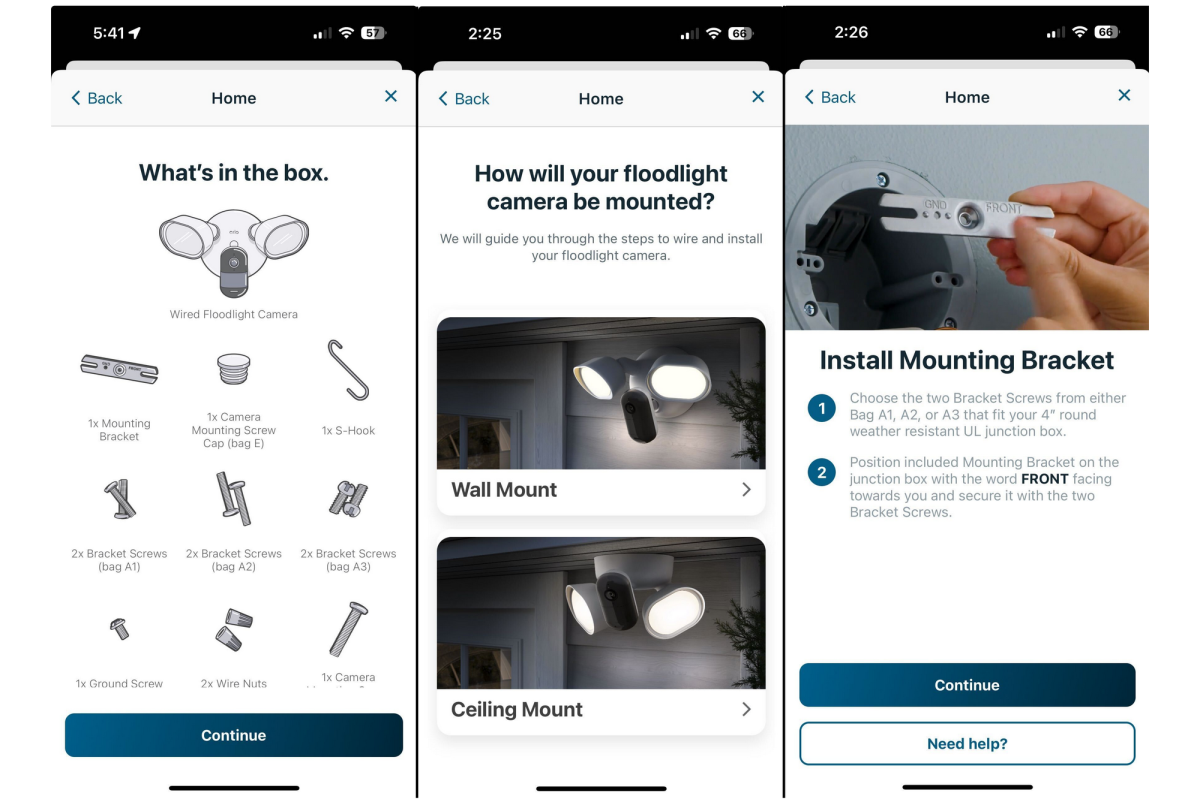
Arlo’s in-app installation instructions and videos are exceptionally good.
Michael Brown/Foundry
My installation would have gone even easier had these wire stubs been just a wee bit longer to give me more room to maneuver, but I got the wires and nuts stuffed back inside the box without too much trouble. The final steps were to simply fasten the light to the bracket using the long screw provided and then to push a rubber cover over the hole. Using just one screw to attach the light’s round base makes it easy to twist the whole assembly back and forth until the lights are level before you tighten it down.
Arlo doesn’t mention it in its instruction manual, but it would be a good idea to apply a bead of caulk to at least the top half of its housing to prevent water from dripping behind it and into the electrical box. The light does have a foam gasket around the back side that contacts the wall, but I’m not certain that would offer enough protection over the long haul.
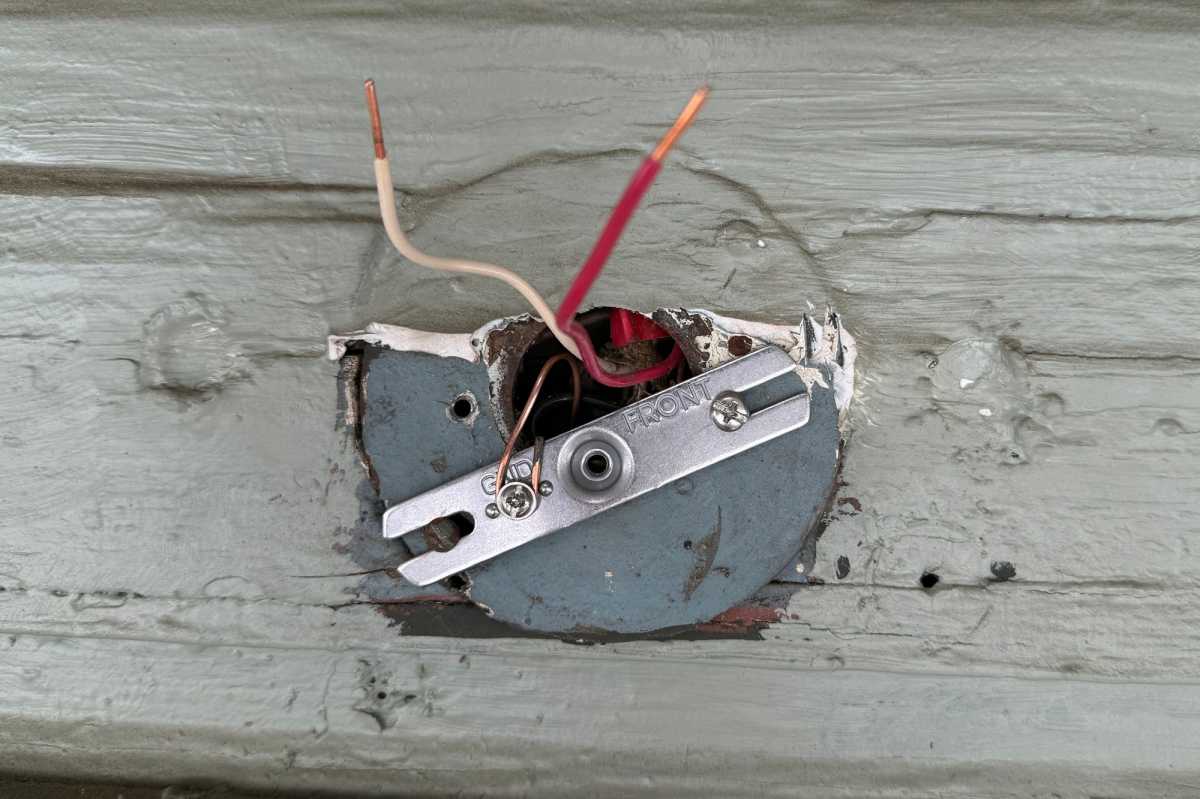
Using a single screw to mount the floodlight camera to its mounting bracket makes it easy to ensure the assembly is level.
Michael Brown/Foundry
Once the physical installation is finished, you’ll restore power to the light, connect it to your Wi-Fi network, add it to the Arlo app, and update its firmware. You can tweak pretty much every aspect of the product once it’s installed, ranging from adjusting the camera’s motion and audio sensitivity (this is one of rare camera’s I’ve tested that can react to sound as well as motion) to the brightness of its LEDs.
You can define as many as five motion detection zones, but you’re limited to drawing resizable rectangles, since each one has control points only at the corners. Most other cameras let you draw more eccentric shapes. Oddly enough, Arlo doesn’t provide any provisions for drawing privacy zones to prevent the camera from capturing neighboring gates, doors, or windows. You might find that you can position the camera so that these elements will be out of its field of view, but it still seems like an omission.
Day-to-day use
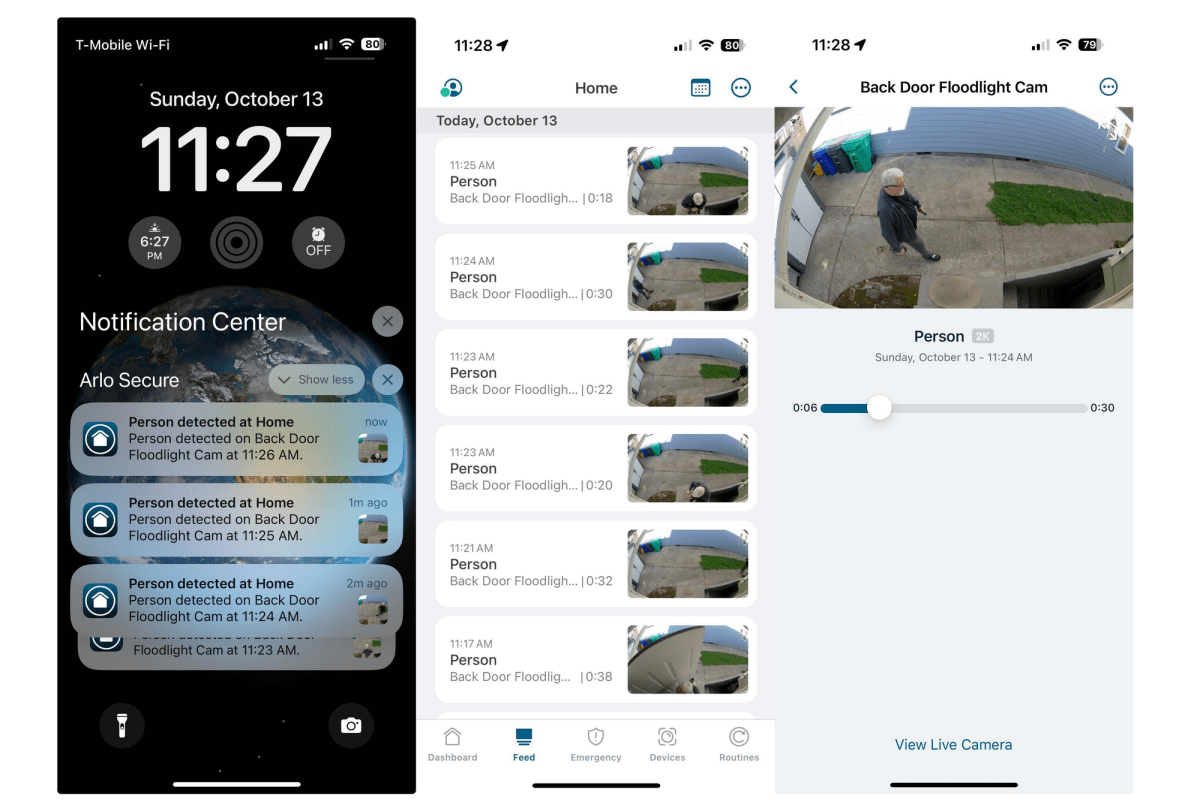
With a subscription, you’ll get instant notifications when motion or audio events trigger the camera to record.
Michael Brown/Foundry
You can operate the camera on a schedule, if you like, and since Arlo uses the same app for its complete home security system, you can also choose from three operational modes based on your current location: Arm Away, Arm Home, and Standby. You can establish custom rules for each mode.
In Arm Away mode, typically used when you’re away from home, you might set a rule where the camera detects motion and/or sound and turns its floodlight on, records a video clip, sounds its siren, and send you a notification. In Arm Home mode, on the other hand, you might want the camera to detect motion, turn on its lights, and record video, but not sound its siren or send you a notification. You can create a third independent set of rules for Standby mode.
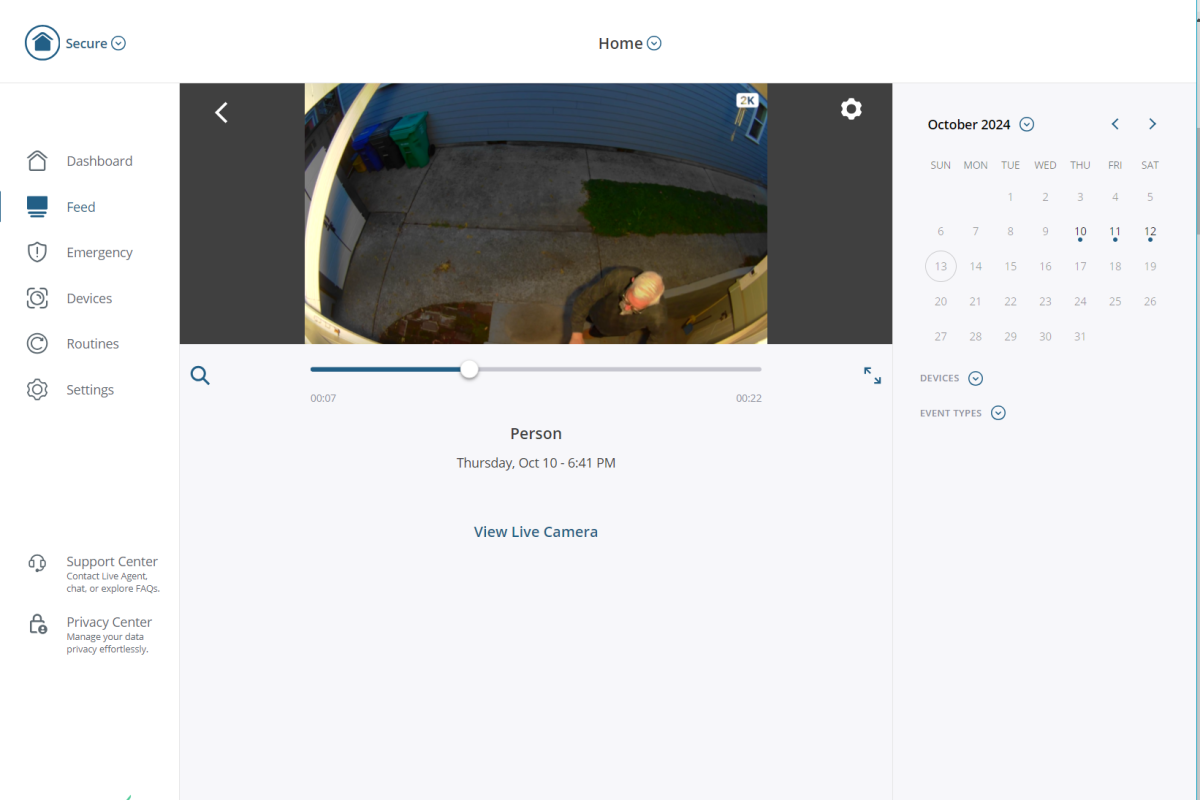
You can also view your camera recordings and manage your system on Arlo’s web portal.
Michael Brown/Foundry
The Arlo Wired Floodlight Camera captures crisp, clear, color-accurate video in 2K resolution with HDR. It’s very responsive to motion, and a Foresight feature captures 3 seconds of video before motion-triggered events, which helps to ensure you see what triggered the camera to record a clip.
Both the camera’s black-and-white and color night vision are excellent, especially if you point the lights in a similar direction as the camera. I directed the lights more to the sides in my installation, because my neighbor’s home is relatively close to mine, and I didn’t want the lights shining in their window. I wouldn’t count on the camera’s siren scaring an intruder off your property or even attracting anyone’s attention. While it’s sufficiently high-pitched, it is not at all loud. I could barely hear it inside my house, so I doubt it would arouse my neighbors’ suspicions.
Should you buy an Arlo Wired Floodlight Camera?
The Arlo Wired Floodlight Camera is affordably priced and easy to install and use. Its camera captures excellent video, and its dimmable lights will illuminate large areas of your property.
If you’re not already in one home security ecosystem or another, and you think you might want to buy a home security system down the road, Arlo is a good place to start. Be sure to factor in the cost of a subscription, however, as this product isn’t of much use without one. When you’re ready to expand your home security footprint, Arlo has a very good basic home security system with a reasonably priced 24/7 professional monitoring plan.
Updated October 17, 2024: We’ve added answers to some fact-check questions that we received after this review was first published.


